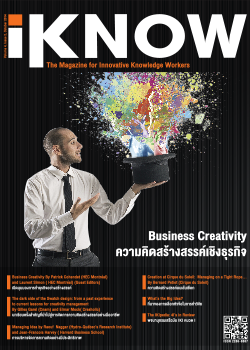iKnow Volume 4 Issue 2

Creative leaders expect to make deeper business model changes to realize their strategies. To succeed, they take more calculated risks, find new ideas, and keep innovating in how they lead and communicate. Thus, embodying creative leadership, reinventing customer relationships, engaging customers as individuals, building operating dexterity, empowering employees through values, amplifying innovation through partnerships, unlocking creative and transversal idea generation through communityship within the organization, are some of the emerging priorities put forward to transform existing organizations into creative businesses. In this special issue of iKNOW, we will focus on some of the new perspectives adopted by leaders to cope with creative challenge, in particular :
1) How to manage disruptive innovation to transform a traditional industry (Gilles Garel and Elmar Mock);
2) the paradoxes of ideation processes to foster creativity in traditional organizations (Raouf Naggar and Jean-François Harvey);
3) How to manage creative talents and the tension that exists between the logic of creators and producers in the case of the Cirque du Soleil (Bernard Petiot).
The case studies selected in this special issue are just three among many examples of actual drastic changes in organisations to cope with creativity. Managing creativity is a challenge for all the different functions of the enterprise. The ways to manage marketing, human resources, logistics, accounting, finance, as well as strategy or planning must all be reconsidered. The IBM CEO Study 2010 shows that even if some managers are reluctant to implement drastic changes in their organization in order to manage creativity, most of them say that they have no choice. If they do not change
their way of doing things, they run the risk of not attracting the best young talent, and to lose touch with their customers.
Managing businesses today is not only about finding them “right”, disruptive business model. Business organizations should be reinvented as flexible, open, and experimental creative powerhouses. This asks for a profound reconfiguring of internal processes in order to generate and harness new ideas through the involvement of talents, and a continual balancing of the development of internal capabilities with an ever-refined attention to present and potential customers’ needs.
Read online / [ddownload id=”436″]
